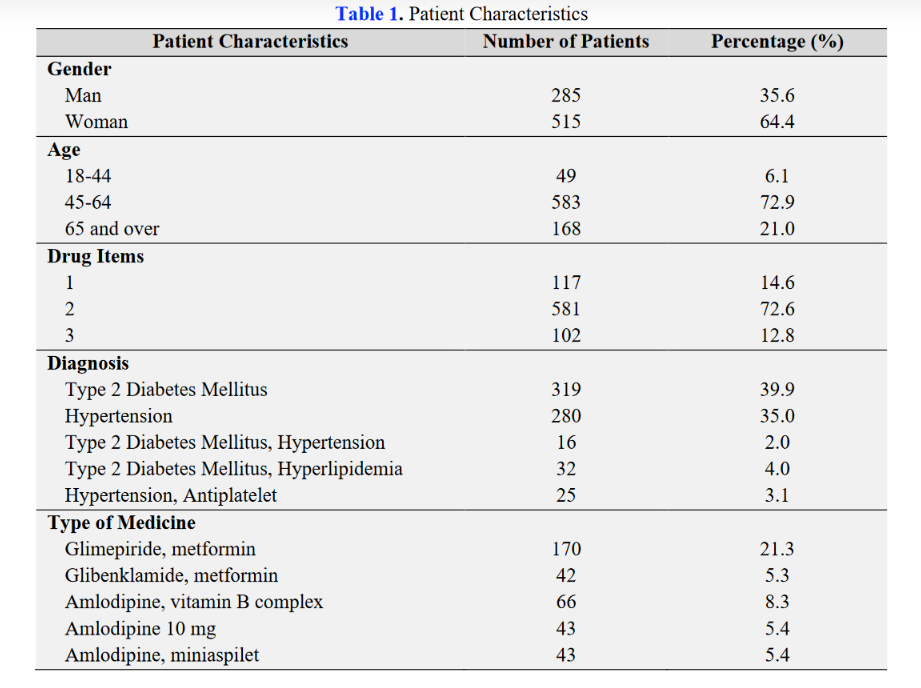Main Article Content
Abstract
To improve the status of public health and carry out social security programs in the health sector, the government started to implement the National Health Insurance. This program covers the participants’ medical care expenses using the capitation system applied in health centers as the First-Level Health Facilities. BPJS Kesehatan has allocated some budget in the form of a capitation rate to first-level health facilities for hypertension and type 2 diabetes mellitus patients after the implementation of National Health Insurance. This research was carried out in 4 health centers, namely Lamper Tengah Health Center, Mangkang Health Center, Mijen Health Center, and Karanganyar Health Center. The data were collected retrospectively from the medical records of 800 patients. The data were analyzed descriptively to determine the prescription cost and Spearman's rho test was used to find the factors that influence the prescription cost. It was revealed that the average prescription cost for type 2 DM patients was IDR 142,293, and for hypertensive patients was IDR 112,735. The prescribing pattern in patients covered by Prolanis program for type 2 DM patients is a combination of glimepiride, metformin with a drug price of IDR 20,670. Factors that have an influence on prescription costs are diagnosis p= 0.033, type of drug (p= 0.000) and drug item (p= 0.000). This study concludes that the factors to influence the drug costs of Prolanis patients at the health centers of Semarang City were the patient's diagnosis, the type of drug given, and the number of drug items given.
Keywords
Article Details

This work is licensed under a Creative Commons Attribution-NonCommercial 4.0 International License.
References
- Al-Maskari, F., El-Sadig, M. and Nagelkerke, N. (2010) ‘Assessment of the direct medical costs of diabetes mellitus and its complications in the United Arab Emirates’, BMC Public Health, 10, pp. 1–10. doi: 10.1186/1471-2458-10-679.
- Ann Watetu, T. et al. (2019) ‘Characteristics of Type 2 Diabetes Patients and Their Association with the Metabolic Syndrome and Cardiovascular Risk Factors at Thika Level Five Hospital in Kenya’, International Journal of Diabetes and Endocrinology, 4(2), p. 35. doi: 10.11648/j.ijde.20190402.11.
- Aodina, F. W. (2019) ‘Higeia Journal of Public Health’, Higeia Journal of Public Health Research and Development, 1(3), pp. 625–634.
- Arifa, A. F. C. (2018) ‘Pengaruh Informasi Pelayanan Prolanis Dan Kesesuaian Waktu Terhadap Pemanfaatan Prolanis Di Pusat Layanan Kesehatan Unair’, Jurnal Administrasi Kesehatan Indonesia, 6(2), p. 95. doi: 10.20473/jaki.v6i2.2018.95-102.
- Ayu, D. P. S. D., Satibi and Diah, A. P. (2015) ‘Analisis Biaya Obat Pada Era Jkn Dan Faktor-Faktor Yang Mempengaruhi Di Fasilitas Penunjang Kesehatan Daerah’, Manajemen dan Pelayanan Faramasi, 5(4), pp. 291–300.
- Badan Penelitian dan Pengembangan Kesehatan (2013) ‘Riset Kesehatan Dasar (RISKESDAS) 2013’, Laporan Nasional 2013. doi: 1 Desember 2013.
- Baroroh, F. and Fathonah, S. S. (2017) ‘Biaya Medik Langsung Terapi Hipertensi Pasien Rawat Jalan Di Rumah Sakit X Yogyakarta’, Jurnal Farmasi Sains dan Praktis, 3(2), pp. 6–13. doi: 10.31603/pharmacy.v3i2.1724.
- Bello Garcés, S. (2018) ‘Ideas previas y cambio conceptual’, Educación Química, 15(3), p. 210. doi: 10.22201/fq.18708404e.2004.3.66178.
- Depkes RI (2014) ‘Peraturan Menteri Kesehatan Republik Indonesia Nomor 27 Tahun 2014 tentang Petunjuk Teknis Sistem Indonesian Case Base Groups (INA-CBGs)’, Kementerian Kesehatan RI.
- Dianingati, R. S. and Prasetyo, S. D. (2015) ‘Analisis Kesesuaian Resep untuk Pasien Jaminan Kesehatan Nasional dengan Indikator Peresepan WHO 1993 pada Instalasi Farmasi Rawat Jalan di RSUD Ungaran Periode Januari-Juni 2014’, Majalah Farmaseutik, 11(3), pp. 362–371.
- Ernawati, C. T. and Uswatul, D. (2019) ‘Hubungan Kepesertaan JKN Mandiri dengan Pendapatan, Pengetahuan, Persepsi, Akses, dan Kepercayaan Masyakat Suku Sakai di Desa Petani Kecamatan Mandau Kabupaten Bengkalis Tahun 2018’, Jurnal Kebijakan Kesehatan Indonesia : JKKI, 8(1).
- ES, H. S., Decroli, E. and Afriwardi, A. (2018) ‘Faktor Risiko Pasien Nefropati Diabetik Yang Dirawat Di Bagian Penyakit Dalam Rsup Dr. M. Djamil Padang’, Jurnal Kesehatan Andalas, 7(2). doi: 10.25077/jka.v7i2.794.
- International Diabetes Federation (2014) ‘Idf Diabetes Atlas 2014 Update’, Diabetes Atlas, six edition.
- Rosdiana, A. I., Raharjo, B. B. and Indarjo, S. (2017) ‘Implementasi Program Pengelolaan Penyakit Kronis (Prolanis)’, Higeia Journal of Public Health Research and Development, 1(3).
- Watetu, T. A., Beatrice, K. N., Onyango Arnold, N., & Anselimo, M. (2021). Characteristics of type 2 diabetes patients and their association with the metabolic syndrome and cardiovascular risk factors at Thika level five Hospital in Kenya.
- WHO (2016) ‘WHO Global report on diabetes: A summary’, International Journal of Noncommunicable Diseases, 1(1). doi: 10.4103/2468-8827.184853.
